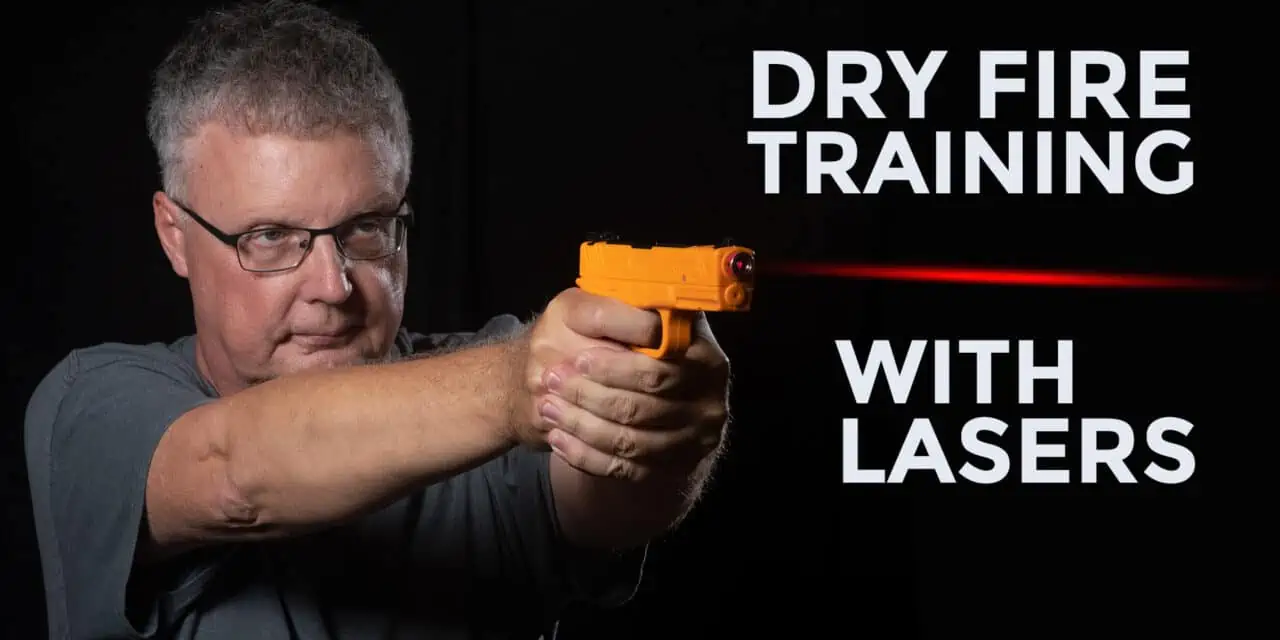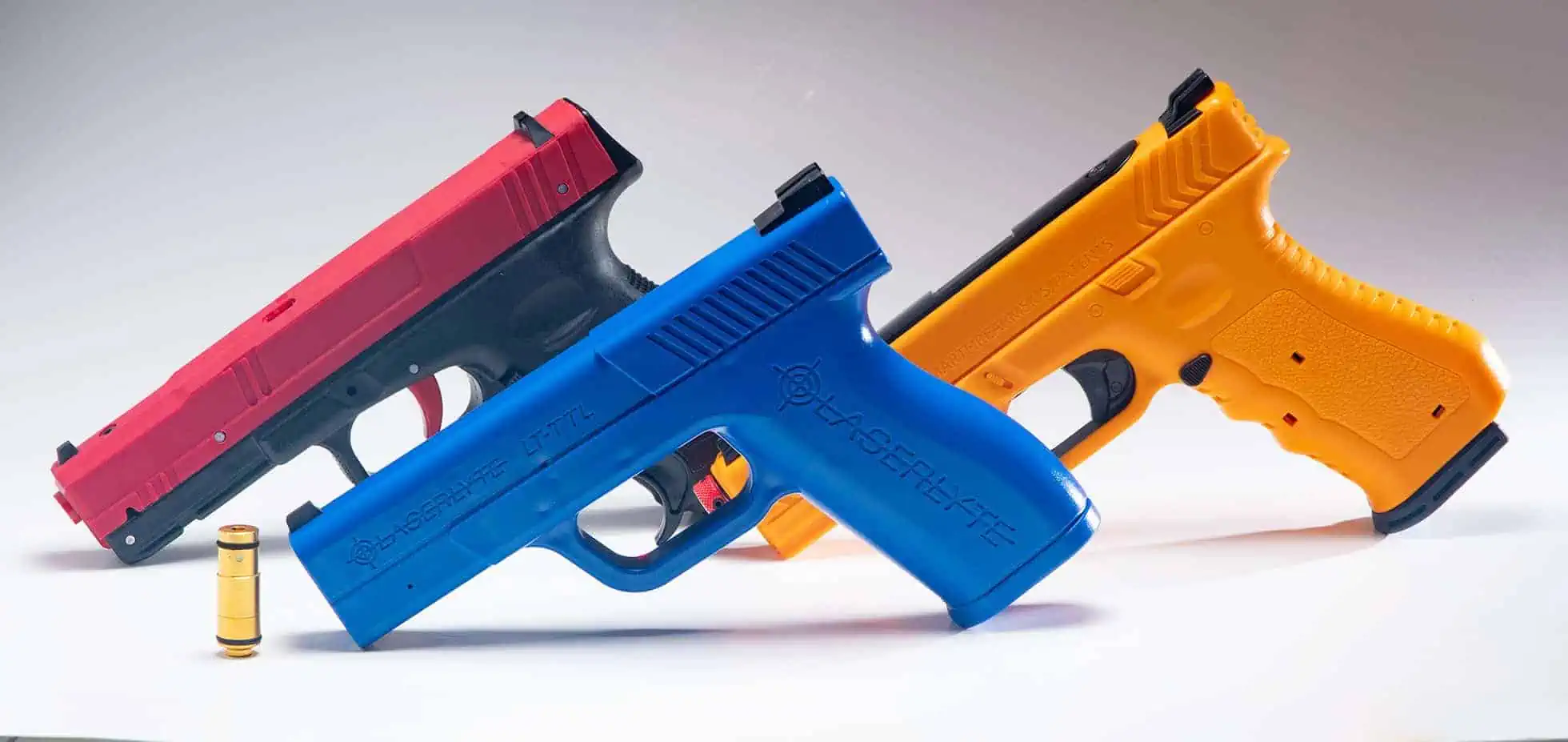Sighting In On The Best Laser Dry Fire Training System
Ammo can be expensive, and time can also be expensive. Unfortunately, you need both ammo and time to become a better marksman. Keeping your skills up to date in an environment where training ammo is in limited supply can be a challenge. That’s exactly why many pistol owners turned to dry fire as a way to keep their skills up to date.
Laser Dry Fire Training System Fast Facts
- Can be either dedicated plastic training gun or a drop-in laser cartridge
- Laser cartridges are cheap, but need an actual gun and strict adherence to safety rules
- Dedicated laser guns let you train almost anywhere, at almost anytime
Let’s begin by addressing what a laser dry fire training system can and cannot do. Recoil is obviously the first thing that’s missing. There are systems out there which use CO2 cartridges to mimic recoil and they can work, but they add extra expense into your regimen, in return for little felt recoil. However, we all know that a solid grip and a proper stance are the keys to taming felt recoil, and that is something you can learn during dry fire without simulating the recoil from your gun.
This article may contain affiliate links. If you click these links and make a dry-fire training system purchase, we may receive a small commission.
Practice With Everything But The Bang
In addition to grip and stance, you can practice sight picture, sight alignment and most importantly, trigger control using a laser dry fire training system. Good trigger control is absolutely essential, especially when shooting pistols. Dry fire training will help you get in the reps to develop a smooth trigger press, and a laser dry fire training system will let you see your progress.
Dry fire works, but it can be rather boring. There is little to no feedback on where your (imaginary) shots are actually landing, and that can get a little tiring. This is why people turn to a laser dry fire training system such as a laser cartridge that fits inside their gun or a dedicated laser gun that mimics the size and shape of an actual pistol. A laser dry fire training system projects a bright dot that shows you where your shot would have landed had it been real rounds you were sending downrange. Let’s take a look at both the laser cartridges and the laser pistols to find what is the best laser dry fire training system for your needs.
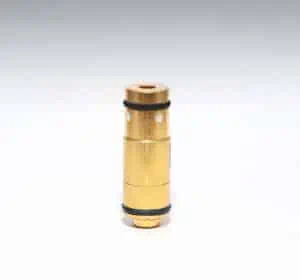 Laser Dry Fire Training System #1: The Laser Cartridge
Laser Dry Fire Training System #1: The Laser Cartridge
A laser training cartridge is the exact size and shape as the actual ammunition your gun uses, but lacks the rim at the back of the shell casing. This design means it can stay inside the chamber of your gun as this slide recycles. You can then reset the trigger on your gun by moving the slide and not have to worry about the laser ammo flying out of your gun and getting lost.
Because you use an unloaded gun with a laser training cartridge, you can practice draws using your holster and carry gear. Just make sure all the live ammo is removed from the room when you practice with your gun, just like you would with any dry fire practice routine. In addition to this, you are using an actual gun in your dry fire practice. This means that the rules of gun safety are in effect, such as keeping the gun pointed in a safe direction at all times.
The fact that laser training ammo resides inside your gun causes other problems. In order to get good command of the trigger, you’ll need to reset the trigger with each shot you take. This is not the case if your pistol is a Double Action Only (DAO) or Double Action / Single Action(DA/SA) gun, which is why I use a pistol like a Sccy CPX-3 or a CZ P07 if I do dry fire with a laser cartridge.
Pros and Cons Of A Laser Training Cartridge
FInally, laser training cartridges are inexpensive. They cost much less than even the least expensive gun-based laser dry fire training system. As we’ll soon see, however, there are some distinct advantages to a dedicated laser training gun. To begin with, with a laser dryfire training gun, there is no need to unload your gun before you start practicing. However, as with all dry fire training, it’s still a good idea to remove all live ammo from the room before you start training.
Although a dedicated laser trainer mimics the shape and feel of a pistol or other firearm, it is made of brightly colored plastic so it is not easily confused with an actual firearm. It can only send light downrange, which can have some effect on your practice. I know top-level trainers who use laser dry fire training systems inside the classroom to teach grip, stance and trigger. This allows them to cover the fundamentals of pistol marksmanship in a controlled, safe environment. The laser guns are obviously not real guns, and can be used in situations where a negligent discharge from a real gun might prove to be catastrophic.
Other Laser Dry Fire Training Systems
Let’s examine three common dedicated laser dry fire training systems available right now, the SIRT 110 from Next Level Training, the SF-30 Pro from Smart Firearms, and the LaserLyte Full Size Laser Training Pistol.
| Model | Manufacturer | Height | Length | Width | Weight | Sights | Trigger Weight (Avg) | Magazine | Features | MSRP As Tested |
|---|---|---|---|---|---|---|---|---|---|---|
| SIRT 110 | Next Level Training | 5 1/8 inches | 7 7/8 inches | 1.13 inches | 21 ounces | Black front and rear | 6 pounds | Removable | Trigger reset | $239 |
| SF-30 PRO | Smart Firearms | 5 3/8 inches | 8 1/4 inches | 1.16 inches | 22 ounces | 3 Dot | 3 pounds, 14 ounces | Removable | Finger on trigger warning, shot sound effects | $358 |
| Full Size | LaserLyte | 4 3/4 inches | 7 3/4 inches | 1.16 inches | 15 Ounces | 3 Dot | 4 lbs, 3 ounces | Fixed | $150 |
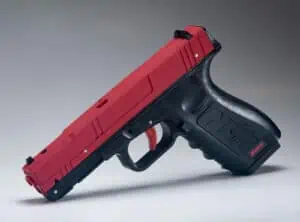 Next Level Training SIRT 110
Next Level Training SIRT 110
Created by top-level USPSA competitor Mike Hughes, the SIRT pistol uses two lasers and mimics the size, shape and feel of a Glock 17 or similar pistol. The SIRT 110 uses two lasers. One laser is activated when you touch the trigger, which shows how much you are moving your gun before you take the shot. The second laser activates when the trigger is fully pressed and shows you where your shot would have landed. The first laser can be turned off and the SIRT 110 will just show your shots, not your gun wobble. There is also an option for a green laser for the second shot placement laser, allowing to easily distinguish between the two dots.
Reset Your Expectations
Another unique feature of the SIRT 110 is that the shot laser stays on if you press and hold the trigger back. This helps you teach you a quick trigger reset, which in turn speeds up your performance in shooting drills such as the Bill Drill. The SIRT 110 has a removable magazine that is weighted like a fully loaded pistol magazine, and additional magazines are available from Next Level Training. This means you can practice common shooting drills like the El Presidente which require a reload, without firing a shot.
The trigger on the SIRT 110 doesn’t replicate the feel of, say, a Glock trigger, but does need a similar amount of effort compared to a real gun, and there is a solid feel to it that is missing from the other two pistols. The sights on the pistol are the notch and post type, and both the front and rear sights are made from black plastic. This makes them quite hard to pick up at times, and getting a good sight picture can be a chore. A dab of bright orange paint or nail polish on the front sight is probably a good idea if you plan on using the SIRT 110 for any length of time.
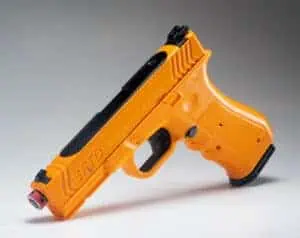 Smart Firearms SF-30 Pro
Smart Firearms SF-30 Pro
In many ways, the SF-30 Pro from Smart Firearms is very similar to the SIRT 110. The SF-30 is about the same size, shape, weight and well-built feel as the SIRT 110. The pistol also has a removable magazine, but it uses different magazines than the SIRT 110. The sights on the SF-30 are the conventional 3 dot variety, and the magazine release is ambidextrous.
Unlike the SIRT pistol, the SF-30 has just one laser. It activates only when you fully press the trigger and then immediately switches off. This means there is no way to tell if you’re holding the trigger back too long (aka “pinning the trigger”) with this pistol. However, the SF-30 does have two unique features that set it apart from the other laser dry fire training systems in our comparison.
SF-30 Pros And Cons
The first is a built-in speaker that makes a “bang” noise when you press the trigger. This is a nice touch if you’re using an SF-30 to train new shooters. To be honest, though, I switched this feature off soon after I started training with this pistol because I know what a shot sounds like. The trigger itself is a bit lighter than the typical trigger on a similar full-sized gun, coming in at just under four pounds of effort needed to make each shot.
The second feature uses a sensor inside the trigger guard along the same speaker that makes the “bang” noise to warn you if you’re breaking one of the rules of gun safety and keeping your finger on the trigger when your gun isn’t on the target. If you leave your finger on the trigger for more than a few seconds, the gun will emit a loud screech and an orange LED on the slide will flash, letting you and your instructor know you need a bit more work on trigger discipline.
Another nice feature of the SF-30 is an option for an invisible infrared laser, for an extra fee. One of the problems I’ve found with using a laser dry fire training system is that it can draw your attention to where your dots are hitting on the wall and away from the front sight. An infrared laser changes this and keeps the focus on your front sight where it belongs. However, you’ll need to record your training sessions with software such as the G Sight or iMarksman apps to see how your shots are landing on the targets.
Get the SF-30 training pistol here.
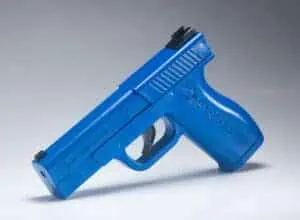 LaserLyte Full Size Training Pistol
LaserLyte Full Size Training Pistol
First off, when LaserLyte says “Full Size,” what they mean is something that is actually around the size of a Glock 19, rather than the larger, Glock 17-sized models we’ve been reviewing so far. The gun itself doesn’t have the solid, chunky feel of the other pistols in our review. However, it has an MSRP of almost $100 less than the other two, allowing you more (virtual) bang for buck.
The trigger on the LaserLyte gun is the “instant on/instant off” variety and has 3 dot sights, just like the setup on the Smart Firearms SF-30. The trigger is lighter than a normal, functioning firearm and has a springy feel to it that is a bit disconcerting at first. There is only one laser in this pistol, and red is the only color choice for your dot.
The lower price of the LaserLyte pistol makes it an attractive option for someone just getting into a laser dry fire training system. It’s also solid for an instructor who is looking to buy a laser dry fire training system for his classroom. The smaller size of the gun means that it’s compatible with holsters and gear that are in common use for concealed carry, rather than the gear for full-size service pistols that the other two pistols use.
Get the LaserLyte Training Pistol for sale here.
Which Is The Best Laser Dry Fire Training System?
The question of who makes the best laser dry fire training system depends a lot on your needs and your budget.
A laser cartridge is clearly a cheaper option. You can pick up 9mm-sized lasers starting at $30 each. However, you need an actual gun to use them correctly. They work best with a DA/SA style of pistol. If you run a striker-fired gun like a Glock or a Sig P320, you’ll need to rack the slide after each shot to get your trigger back into a working condition. This means that any drill that requires multiple shots (which is practically all pistol drills, if we’re honest) will be done with a dead, non-functioning trigger, or you’ll need to work the slide with each shot.
You’ll get some distinct advantages if you invest in a dedicated laser training pistol. There’s no need to unload your gun to dry fire with this type of laser dry fire training system. The trigger works each time you press it. They’re not cheap, however, and there isn’t one “do it all” gun out there that has all the available features wrapped up in one gun. For myself, I practice my draw with the LaserLyte pistol because it fits easily into my concealed carry holster. I use the SIRT 110 when I want to work on trigger control or one-handed shooting. The Smart Firearms SF-30 is ideal for teaching new students not to let their trigger finger dwell too long when it’s not in use.
Training Is The Key
Whichever laser dry fire training system you choose, it’s not going to improve your shooting all by itself. Regular dry fire practice and then confirmation with live-fire drills is what improves your marksmanship. Buying gear is great, but buying gear doesn’t build confidence. Putting yourself to the test and then passing that test is what builds confidence and skill, a skill that one day may save your life.

